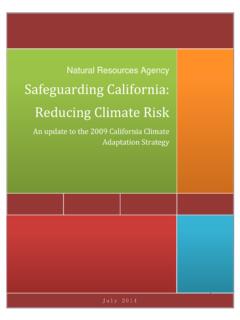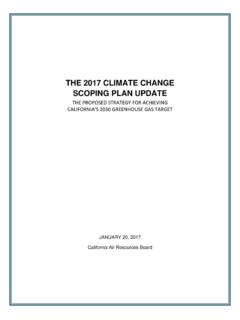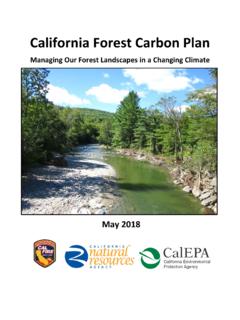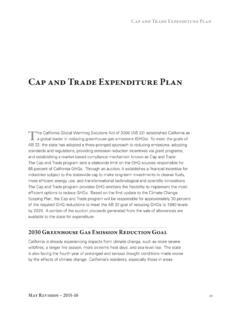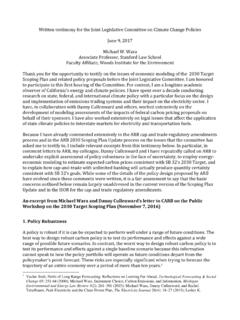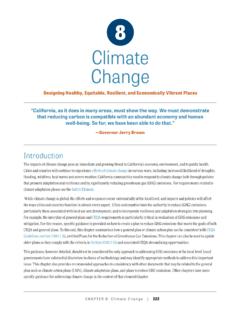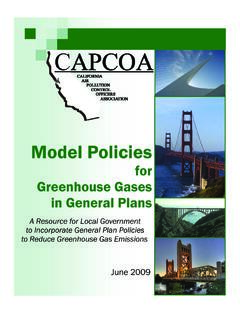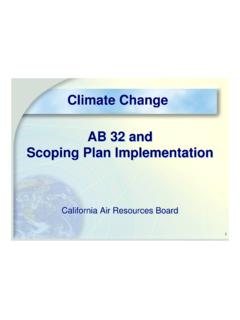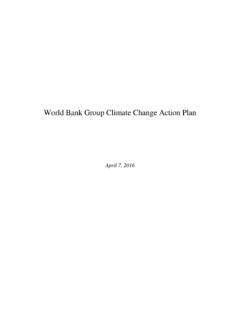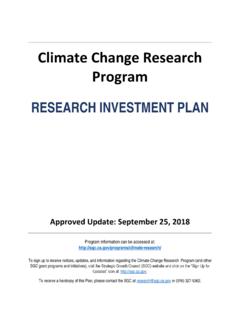Transcription of Solid Waste Industry Group Solid Waste Industry for ...
1 1 Solid Waste Industry Group Solid Waste Industry for climate solutions California State Association of Counties Inland Empire Disposal Association League of California Cities Los Angeles County Waste Management Association Republic Services, Inc. Rural County Representatives of California Solid Waste Association of Orange County Waste Management May 21, 2014 Mary Nichols, Chair California Air Resources Board 1001 I Street Box 2815 Sacramento, CA 95812 Subject: First Proposed Update to the climate Change scoping plan Dear Ms. Nichols: The undersigned Solid Waste /recycling companies and local government representatives, identified collectively as the Solid Waste Industry Group (SWIG) and the Solid Waste Industry for climate solutions (SWICS), appreciate the opportunity to submit these comments on the Air Resources Board s first proposed update to the climate Change scoping plan .
2 This letter follows on earlier comments we submitted on July 12, 2013 and November 1, 2013. As we noted in our earlier letters, our goal remains to work collaboratively with the ARB as well as CalRecycle, other state agencies and the Legislature to develop a plan to achieve greater Waste diversion and additional GHG emission reductions that is practical, feasible, financially sustainable and effective. We appreciate the ARB s acknowledgment in the scoping plan Update (SPU, pp. 66-68) that much already has been done in the Waste sector to reduce GHG emissions: 2 In 2009 the ARB adopted, pursuant to its initial scoping plan , the Landfill Methane Rule (LMR), to improve the capture of methane and reduce methane emissions. Prior to this measure the ARB estimated that about 78% of landfill methane emissions were being captured and controlled; the ARB estimated this measure alone would reduce landfill methane emissions by an additional 25%, increasing the collection rate to an average of 83%.
3 In 2011 AB 341 was enacted, establishing a statewide goal that by 2020 75% of Solid Waste generated in the state will be reduced, recycled or composted. In 2012, CalRecycle adopted regulations to require recycling in the commercial sector, the first major step to achieve AB 341 s 75% goal. All of these measures build upon California s landmark AB 939, which required local jurisdictions to divert at least 50% of their Waste from landfills by 2000. As of 2012 the statewide diversion rate was a very impressive 66%. California s private Solid Waste and recycling companies, public agencies and local governments have been the on-the-ground workhorses ensuring that these Waste diversion and GHG reduction targets are met and exceeded.
4 And we are continuing to work to achieve further reductions and increase Waste reduction and recycling. We agree with the ARB that the primary source of GHG emissions from the Waste sector is from landfilled organic materials (SPU, p. 66) and the best way to achieve further GHG emission reductions from the Waste sector is by meeting the AB 341 75% recycling goal (SPU, p. 67). Accordingly, we are working closely with the authors and sponsors of two bills currently in the Legislature AB 1826 (Chesbro) and AB 1594 (Williams) to further divert organic Waste from landfills and reuse it as feedstock for compost, very low carbon fuels, and other secondary products. We offer the following comments on the six actions recommended by the ARB (SPU, p.)
5 97) to achieve further reductions from the Waste sector. 1. Eliminate disposal of organic materials at landfills through mandatory commercial organics recycling and eliminating diversion credit for green Waste ADC: AB 1826 (Chesbro) builds on the model established in AB 341 by establishing mandatory commercial organics recycling requirements and requiring local governments to implement organic Waste recycling programs. Under AB 1826, organics recycling programs will be initiated statewide only one year after enactment, in January 2016, and will be fully implemented by 2019. AB 1594 (Williams) will eliminate the diversion credit for green Waste used as alternative daily cover at landfills, creating an additional incentive to divert green material from landfills and reuse it as feedstock for compost and other products.
6 Together we believe these two measures will have a significant impact not only on diverting organic materials from landfills and reducing GHG emissions, but also in enhancing markets for products made from organic Waste . A broad coalition of Solid Waste /recycling companies and local government representatives have been working with the authors and sponsors of both bills to 3 address remaining concerns and get to a position of support, which we are confident we will achieve. 2. Implement financing or incentive mechanisms to support in-state Waste sector infrastructure: We applaud the ARB or recognizing the importance of this measure. Combined with the permitting and siting concerns described in #3, we are quite concerned about the availability of infrastructure needed to process the large amounts of additional organic Waste that will be diverted from landfills in the near future.
7 3. Address permitting and siting challenges associated with composting and anaerobic digestion: Our coalition applauds the ARB for making this issue a priority. Composting and anaerobic digestion facilities are only two of the many kinds of new facilities and technologies that California will need to permit and site in a timely manner to achieve AB 32 s goals. To maximize the economic viability of composting and AD projects, they will need to be sited within a reasonable distance of the source of the organic materials, which for the most part will be urban population centers, where permitting and siting difficulties often are most acute. In southern California. For example, compost facilities face very rigorous rules from the South Coast Air Quality Management District, which make permitting of these facilities extremely difficult.
8 And organic Waste processing facilities in all parts of the state, rural and urban alike, often face local opposition based at least in part on the very nature of the feedstock. 4. Consider additional methane control measures at landfills and use captured methane as fuel source: We believe there is indeed much for the ARB to consider before deciding whether additional methane control measures at landfills are justified. It has been five years since the ARB adopted its existing LMR. Although the ARB estimated this measure would reduce remaining landfill methane emissions by 25%, the ARB also admits that landfill emissions are difficult to estimate and are subject to substantial uncertainty (ARB, Landfill White Paper). We certainly agree that the study cited used by the ARB to derive landfill emissions for the scoping plan ( Measured and Modeled Methane Emissions at Closed MSW Landfills Without Gas Collections [Avoided Landfill Emissions Report]) is an inadequate source to guide future decisions: its results are based on an evaluation at a single landfill; that landfill was not subject to the LMR when it was evaluated; the report itself declares that its collection efficiencies have significant uncertainty; and the report calls for additional research on landfill methane emissions.
9 In response to what we saw as the deficiencies of the Avoided Landfill Emissions Report, and in direct response to the report s call for more research, the Solid Waste Industry for climate solutions (SWICS), including many signers of this letter, commissioned an analysis to evaluate landfill methane collection rates at California landfills based on direct emission measurements at landfills, as opposed to default estimated emissions used in the Avoided Landfill Emissions Report. Unlike that report, the SWICS analysis 4 measures emissions at actual California landfills, including landfills with comprehensive gas collection systems that would be expected to meet the requirements of the LMR The ARB s LMR became effective in June 2010 and is being implemented at virtually all California landfills.
10 The rule is enforced by air districts and, based on the findings of the SWICS analysis, we believe it is highly effective at reducing landfill methane emissions. But at a minimum, the ARBH should thoroughly evaluate the efficacy of the LMR, based on analysis of emissions from landfills where the LMR has been implemented, before deciding whether to adopt additional landfill emission control measures. In addition, the ARB should consider the likely emission reductions that will result from AB 1826 and AB 1594, if enacted. These two measures are consistent with the ARB s own recommendations, and it is only appropriate to allow these measures to take effect before determining the incremental benefits to be gained by further landfill control measures.
